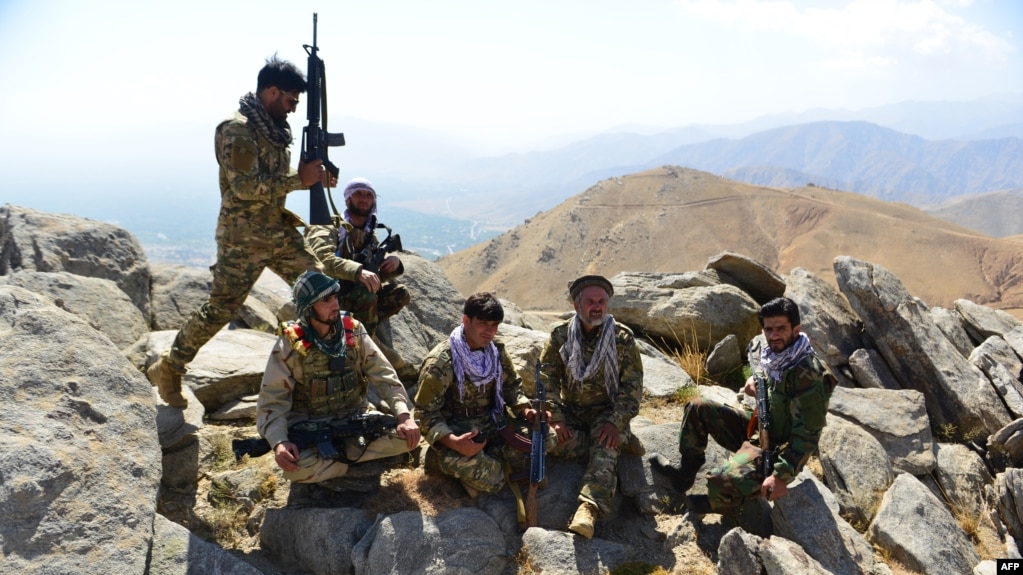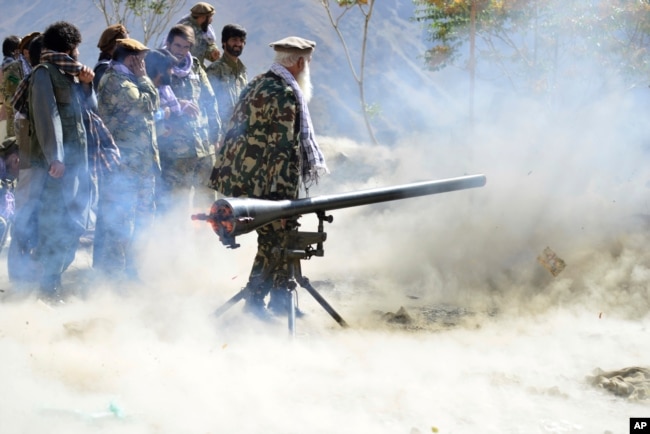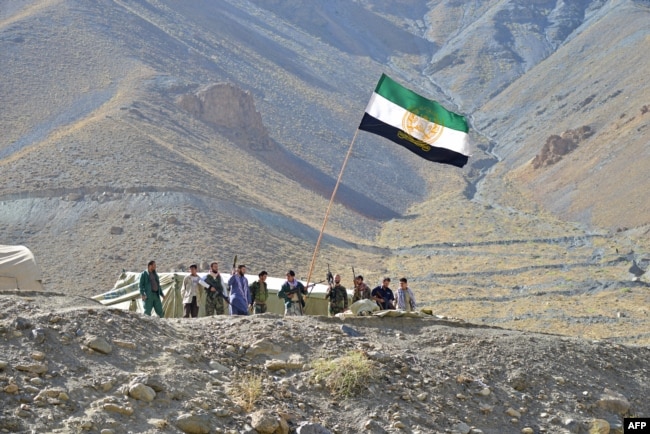August 14, 2022
Khalid Mafton

Afghan resistance movement and anti-Taliban forces take a break as they patrol on a hilltop in the Darband area of Anaba district, in Afghanistan's Panjshir province, Sept. 1, 2021.
WASHINGTON —
A year into their rule, armed political opposition to the Taliban remains persistent but sporadic, concentrated mostly in northern Afghanistan, and possibly fueled by the Taliban refusal to form an inclusive government and give other entities a share in power.
"The Taliban continue to hold power almost exclusively. The emergence and persistence of an armed opposition is in large part due to political exclusion,” Ramiz Alakbarov, the United Nations’ deputy special representative for Afghanistan told the Security Council in June.
The National Resistance Front of Afghanistan, the main group opposing Taliban militarily, tried to carve out a stronghold in its historic base Panjshir valley last year when the Taliban took the country over in a near Blitzkrieg but could not hold out for long.
“The opposition group is very weak. It only survived two or three weeks in Panjshir valley. So, I think, the Taliban is unfortunately in a stronger position,” said Peter Bergen, vice president for global studies and a fellow at New America, a nonpartisan Washington think tank.

WASHINGTON —
A year into their rule, armed political opposition to the Taliban remains persistent but sporadic, concentrated mostly in northern Afghanistan, and possibly fueled by the Taliban refusal to form an inclusive government and give other entities a share in power.
"The Taliban continue to hold power almost exclusively. The emergence and persistence of an armed opposition is in large part due to political exclusion,” Ramiz Alakbarov, the United Nations’ deputy special representative for Afghanistan told the Security Council in June.
The National Resistance Front of Afghanistan, the main group opposing Taliban militarily, tried to carve out a stronghold in its historic base Panjshir valley last year when the Taliban took the country over in a near Blitzkrieg but could not hold out for long.
“The opposition group is very weak. It only survived two or three weeks in Panjshir valley. So, I think, the Taliban is unfortunately in a stronger position,” said Peter Bergen, vice president for global studies and a fellow at New America, a nonpartisan Washington think tank.

Militiamen loyal to Ahmad Massoud, son of the late Ahmad Shah Massoud, take part in a training exercise, in Panjshir province, northeastern Afghanistan, Monday, Aug. 30, 2021.
The NRFA is led by Ahmad Massoud, the son of famed anti-Taliban military commander Ahmad Shah Massoud, who followers called the Lion of Panjshir. The older Massoud commanded the Northern Alliance and, according to Bergen, received support from several countries including Tajikistan, Iran, Russia, and the United States.
His son, however, has received nothing from these countries, or any other country for that matter, so far.
"The Taliban are in a stronger position than they were before 9/11,” Bergen, who has written seven books on terrorism and extremism, told VOA.
Al-Qaida assassinated Ahmad Shah Massoud just two days before the attacks on the United States in September of 2001 that led to the invasion of Afghanistan.
US weapons
The weapons and equipment left behind in Afghanistan after the withdrawal of the U.S. forces from Afghanistan last year and the collapse of the Western-backed republic in the country has also put Taliban in a stronger position and allowed them to use these weapons to further strengthen their grasp on power in the country.
According to the U.S. authorities, the Taliban now have access to weapons worth tens of billions of dollars.
An Afghan security analyst who, for security reasons, asked not to be named, told VOA, the Taliban are already using these weapons to suppress the armed opposition in the north.
"The Taliban have the upper hand in terms of military equipment, because according to U.S. officials, modern weapons worth $85 billion have fallen into the hands of this group," the analyst said.
Bergen said armed opposition to the Taliban is difficult without support from other countries and organizations.
"I do not see any evidence that outside countries are really supporting the opposition movements,” he said.
Western diplomats in the region told VOA there is no appetite for supporting an armed resistance against the Taliban.
Potential failure
Rand Corporation analyst Idrees Rahmani, who closely follows developments in Afghanistan, seconds Bergen’s assessment and warns that the anti-Taliban opposition will fail if it does not receive foreign support.
"Every war is won by its logistics and financial support,” Rahmani said.
“Neither Russia nor Iran or Tajikistan are willing to match the support that Taliban are receiving. India alone might not have the interest to invest in their [armed opposition] cause,” Rahmani added.
Symbolism
Gianni Koskinas, a senior fellow with the International Security Program at New America, a Washington-based think tank, said he believes the NRFA’s initial fight against the Taliban was more symbolic than real. He said it all boils down to the NRFA’s long-term strategy.
"With ISIS [the Islamic State group] as a bigger threat, the Taliban will concentrate on countering this group over the NRFA,” Koskinas said.
“Rather than rushing to failure, the NRFA must take the time to rebuild and establish defensive safe zones, not try to expand territory prematurely,” he added.
Koskinas, who worked in Afghanistan for years, said he believes that with safe zones and a sanctuary for persecuted former Afghan national security and defense forces, who were disenfranchised after the departure of former Afghan President Ashraf Ghani from the country, the NRFA can really change the military situation its advantage.
"NRFA must create zones outside of Panjshir. This will take time, patience, intelligence, strategy, nuance, and sacrifices,” he added.

The NRFA is led by Ahmad Massoud, the son of famed anti-Taliban military commander Ahmad Shah Massoud, who followers called the Lion of Panjshir. The older Massoud commanded the Northern Alliance and, according to Bergen, received support from several countries including Tajikistan, Iran, Russia, and the United States.
His son, however, has received nothing from these countries, or any other country for that matter, so far.
"The Taliban are in a stronger position than they were before 9/11,” Bergen, who has written seven books on terrorism and extremism, told VOA.
Al-Qaida assassinated Ahmad Shah Massoud just two days before the attacks on the United States in September of 2001 that led to the invasion of Afghanistan.
US weapons
The weapons and equipment left behind in Afghanistan after the withdrawal of the U.S. forces from Afghanistan last year and the collapse of the Western-backed republic in the country has also put Taliban in a stronger position and allowed them to use these weapons to further strengthen their grasp on power in the country.
According to the U.S. authorities, the Taliban now have access to weapons worth tens of billions of dollars.
An Afghan security analyst who, for security reasons, asked not to be named, told VOA, the Taliban are already using these weapons to suppress the armed opposition in the north.
"The Taliban have the upper hand in terms of military equipment, because according to U.S. officials, modern weapons worth $85 billion have fallen into the hands of this group," the analyst said.
Bergen said armed opposition to the Taliban is difficult without support from other countries and organizations.
"I do not see any evidence that outside countries are really supporting the opposition movements,” he said.
Western diplomats in the region told VOA there is no appetite for supporting an armed resistance against the Taliban.
Potential failure
Rand Corporation analyst Idrees Rahmani, who closely follows developments in Afghanistan, seconds Bergen’s assessment and warns that the anti-Taliban opposition will fail if it does not receive foreign support.
"Every war is won by its logistics and financial support,” Rahmani said.
“Neither Russia nor Iran or Tajikistan are willing to match the support that Taliban are receiving. India alone might not have the interest to invest in their [armed opposition] cause,” Rahmani added.
Symbolism
Gianni Koskinas, a senior fellow with the International Security Program at New America, a Washington-based think tank, said he believes the NRFA’s initial fight against the Taliban was more symbolic than real. He said it all boils down to the NRFA’s long-term strategy.
"With ISIS [the Islamic State group] as a bigger threat, the Taliban will concentrate on countering this group over the NRFA,” Koskinas said.
“Rather than rushing to failure, the NRFA must take the time to rebuild and establish defensive safe zones, not try to expand territory prematurely,” he added.
Koskinas, who worked in Afghanistan for years, said he believes that with safe zones and a sanctuary for persecuted former Afghan national security and defense forces, who were disenfranchised after the departure of former Afghan President Ashraf Ghani from the country, the NRFA can really change the military situation its advantage.
"NRFA must create zones outside of Panjshir. This will take time, patience, intelligence, strategy, nuance, and sacrifices,” he added.

Afghan resistance movement and anti-Taliban uprising forces stand guard on a hilltop in the Astana area of Bazarak in Panjshir province on Aug.27, 2021, as among the pockets of resistance against the Taliban following their takeover of Afghanistan.
Taliban Recognition
While the armed opposition has not been able to secure outside support, the Taliban, too, have been unable to gain recognition almost a year into their return to power following a bloody two-decade war that changed them from an insurgent force into a de facto state actor. Even Pakistan, deemed by some as Taliban's close ally, has not yet hinted at formally recognizing the group as a state actor in Afghanistan.
Pakistani officials have said in recent months that they told the Taliban government that Islamabad will extend diplomatic recognition only after other nations do.
In early July, the United States also said no foreign government is contemplating legitimacy for Taliban rule in Afghanistan.
Donald Lu, U.S. assistant secretary of state for South and Central Asia said that there is a global consensus when it comes to Taliban recognition.
“I think there’s actually a global consensus to include Moscow and Beijing and Iran, that it’s too early to look at recognition,” Lu told VOA in a recent interview.
“Yes, some countries are beginning a very slow process of normalization of relations [with the Taliban]. No one is talking about formal recognition,” he added.
Pockets of resistance
The NRFA’s armed groups are militarily active in northern Panjshir province, the neighboring Baghlan province’s Andarab and Khost wa Fereng districts and in the Warsaj district of northern Takhar province.
There have been reported clashes between the Taliban and NRFA in pockets of the north, with both sides claiming that they caused heavy causalities to the opposing side.
The NRFA’s media wing has been very active and regularly claims that they have killed, injured, and captured Taliban members, but Taliban officials deny these claims as "baseless."
For this story VOA has reached out to Taliban officials for comment. They declined to talk about this issue.
Taliban spokesman Zabihullah Mujahid, however, has denied clashes between the Taliban and NRFA fighters in Panjshir Province and Andarab area in the past, alleging that “the issues reported by some rebel circles on social media are baseless."
"No one should worry. Thousands of forces of the Islamic Emirate of Afghanistan are present in Panjshir, Takhar and other areas. The enemy will not be allowed to make any move," Mujahid tweeted in Dari, one of the main languages of Afghanistan, in early May of this year.
NRFA’s side
Despite skepticism of some western experts and analysts, and the denial from Taliban about NRFA’s activities and potential, the group has projected confidence and optimism about its struggle.
"The Taliban remain a terrorist group. Afghans definitely cooperate with the NRF. We have the support of the people of the country,” Sibghatullah Ahmadi, NRFA’s spokesperson told VOA.
“The resources the Taliban have at their disposal are not more than the resources of the communist government [Soviet Union backed government in the 80s], but the people of Afghanistan were determined and overthrew the communist government,” Ahmadi added.
Front line accounts
Major Gen. Jalaluddin Yaftaly, Former Commanding General of the 203 Corp of the former Afghan security forces, told VOA that he is actively leading fighters in north of Afghanistan.
"Our overall goal is to continue our struggle until our people and nation are rescued from oppression and tyranny,” Yaftaly told VOA.
“If God makes us victorious and enables us to retake Afghanistan, our government will be a federal and decentralized system,” he added.
Jamal Andarabi, who uses this pseudonym for security reasons, is a local commander of 15 to 20 armed men in Andarab district of northern Baghlan province spoke with VOA from Andarab area where men under his command actively engage the Taliban.
"We fight against terrorists to defend our language, ethnicity, geography and ethnic values,” he said.
“The Taliban, with all the equipment they have, have been defeated in the last few days’ armed clashes [in Andarab district]. We are victorious in the battlefield,” he added.
Bergen, of Global Strategies, said that the odds favor the Taliban now as they exercise monopoly over the use of force and control almost the entire country. But things could change if the Taliban make the wrong move and Western security is threatened by terror groups emanating from Afghanistan.
VOA Afghan Service contributed to this story.
Taliban Recognition
While the armed opposition has not been able to secure outside support, the Taliban, too, have been unable to gain recognition almost a year into their return to power following a bloody two-decade war that changed them from an insurgent force into a de facto state actor. Even Pakistan, deemed by some as Taliban's close ally, has not yet hinted at formally recognizing the group as a state actor in Afghanistan.
Pakistani officials have said in recent months that they told the Taliban government that Islamabad will extend diplomatic recognition only after other nations do.
In early July, the United States also said no foreign government is contemplating legitimacy for Taliban rule in Afghanistan.
Donald Lu, U.S. assistant secretary of state for South and Central Asia said that there is a global consensus when it comes to Taliban recognition.
“I think there’s actually a global consensus to include Moscow and Beijing and Iran, that it’s too early to look at recognition,” Lu told VOA in a recent interview.
“Yes, some countries are beginning a very slow process of normalization of relations [with the Taliban]. No one is talking about formal recognition,” he added.
Pockets of resistance
The NRFA’s armed groups are militarily active in northern Panjshir province, the neighboring Baghlan province’s Andarab and Khost wa Fereng districts and in the Warsaj district of northern Takhar province.
There have been reported clashes between the Taliban and NRFA in pockets of the north, with both sides claiming that they caused heavy causalities to the opposing side.
The NRFA’s media wing has been very active and regularly claims that they have killed, injured, and captured Taliban members, but Taliban officials deny these claims as "baseless."
For this story VOA has reached out to Taliban officials for comment. They declined to talk about this issue.
Taliban spokesman Zabihullah Mujahid, however, has denied clashes between the Taliban and NRFA fighters in Panjshir Province and Andarab area in the past, alleging that “the issues reported by some rebel circles on social media are baseless."
"No one should worry. Thousands of forces of the Islamic Emirate of Afghanistan are present in Panjshir, Takhar and other areas. The enemy will not be allowed to make any move," Mujahid tweeted in Dari, one of the main languages of Afghanistan, in early May of this year.
NRFA’s side
Despite skepticism of some western experts and analysts, and the denial from Taliban about NRFA’s activities and potential, the group has projected confidence and optimism about its struggle.
"The Taliban remain a terrorist group. Afghans definitely cooperate with the NRF. We have the support of the people of the country,” Sibghatullah Ahmadi, NRFA’s spokesperson told VOA.
“The resources the Taliban have at their disposal are not more than the resources of the communist government [Soviet Union backed government in the 80s], but the people of Afghanistan were determined and overthrew the communist government,” Ahmadi added.
Front line accounts
Major Gen. Jalaluddin Yaftaly, Former Commanding General of the 203 Corp of the former Afghan security forces, told VOA that he is actively leading fighters in north of Afghanistan.
"Our overall goal is to continue our struggle until our people and nation are rescued from oppression and tyranny,” Yaftaly told VOA.
“If God makes us victorious and enables us to retake Afghanistan, our government will be a federal and decentralized system,” he added.
Jamal Andarabi, who uses this pseudonym for security reasons, is a local commander of 15 to 20 armed men in Andarab district of northern Baghlan province spoke with VOA from Andarab area where men under his command actively engage the Taliban.
"We fight against terrorists to defend our language, ethnicity, geography and ethnic values,” he said.
“The Taliban, with all the equipment they have, have been defeated in the last few days’ armed clashes [in Andarab district]. We are victorious in the battlefield,” he added.
Bergen, of Global Strategies, said that the odds favor the Taliban now as they exercise monopoly over the use of force and control almost the entire country. But things could change if the Taliban make the wrong move and Western security is threatened by terror groups emanating from Afghanistan.
VOA Afghan Service contributed to this story.
No comments:
Post a Comment